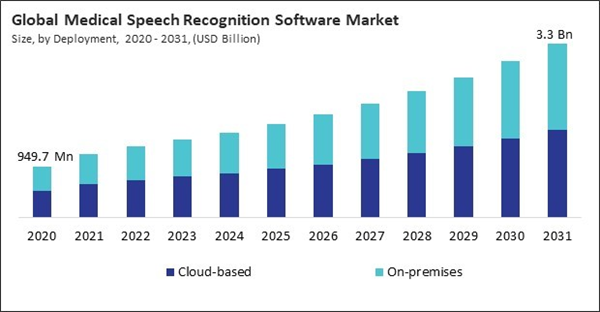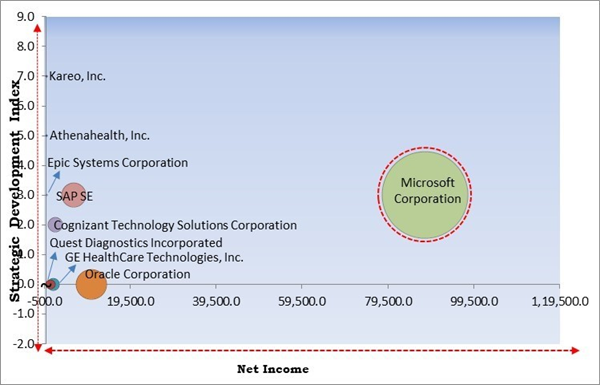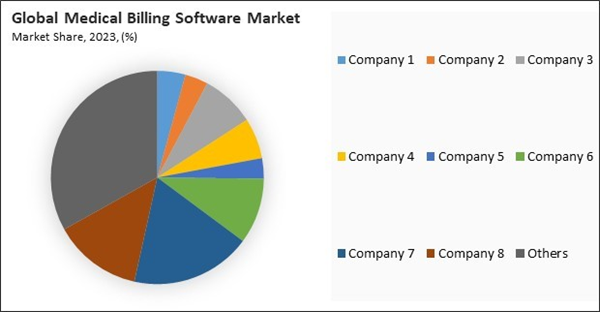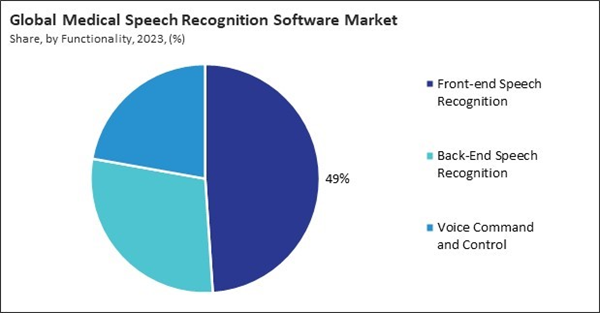The rise in chronic diseases such as diabetes, hypertension, and cardiovascular conditions, along with an aging population, leads to more complex healthcare needs and billing scenarios. Chronic disease management often involves multiple visits, ongoing treatments, and various types of services, which increases the complexity of medical billing. Medical billing software in China must evolve to handle intricate billing processes, including long-term care management, frequent monitoring, and multi-service treatments. Thus, the Asia Pacific region acquired 26% revenue share in the market 2023.
The major strategies followed by the market participants are Product Launch as the key developmental strategy to keep pace with the changing demands of end users. For instance, In March, 2022, Epic Systems Corporation unveiled Garden Plot, a SaaS for independent medical groups, offering access to Epic EHR tools and various third-party products with minimal overhead.
Unlike the Community Connect program, Garden Plot provides direct Epic access and support for groups with over 40 providers, aiming for high-quality, community-driven care. Additionally, In November, 2020, Kareo launched Kareo Patient Collect, a new patient payment collections solution. This solution is designed specifically for independent healthcare practices and medical billing companies. Kareo Patient Collect improves the payment experience for patients and maximizes patient collections for providers.
The Cardinal Matrix - Market Competition Analysis
Based on the Analysis presented in the Cardinal matrix; Microsoft Corporation is the forerunner in the Medical Billing Software Market. Companies such as Oracle Corporation, Cognizant Technology Solutions Corporation, and SAP SE are some of the key innovators in Medical Billing Software Market. In January, 2024, Microsoft Corporation unveiled its AI tool, DAX Copilot, to automate clinical documentation within Epic's health records software. Integrated into Epic's Haiku mobile app, the tool drafts clinician notes for immediate review, aiming to streamline the time-consuming note-taking process, a frequent complaint in healthcare systems.
Market Growth Factors
Medical billing software integrates various functions such as patient registration, insurance verification, charge capture, and claims processing into a unified system. This integration enhances visibility into the entire revenue cycle, enabling healthcare providers to identify bottlenecks, optimize workflows, and improve cash flow. Automation in RCM ensures timely follow-ups on unpaid claims and reduces the days in accounts receivable. In conclusion, increased focus on automation and efficiency drives the market’s growth.Additionally, medical billing software helps mitigate these issues by automating the billing process, reducing the likelihood of errors, and ensuring that all services provided are accurately captured and billed. This reduces revenue leakage and maximizes the financial returns for healthcare providers. In conclusion, rising healthcare expenditure necessitating efficient billing systems drives the market’s growth.
Market Restraining Factors
Implementing medical billing software involves a comprehensive planning phase that requires a detailed analysis of existing billing processes, workflows, and system requirements. Healthcare providers must assess their current infrastructure, identify improvement areas, and develop a detailed implementation plan. In conclusion, the complexity and time required for implementation impede the market’s growth.The leading players in the market are competing with diverse innovative offerings to remain competitive in the market. The above illustration shows the percentage of revenue shared by some of the leading companies in the market. The leading players of the market are adopting various strategies to cater demand coming from the different industries. The key developmental strategies in the market are Acquisitions, and Partnerships and Collaborations.
Driving and Restraining Factors
Drivers
- Increased focus on automation and efficiency
- Rising healthcare expenditure necessitates efficient billing systems
- Growing prevalence of chronic diseases increases billing complexity
Restraints
- High initial costs and ongoing maintenance expenses
- Complexity and time required for implementation
Opportunities
- Rising demand for mobile and cloud-based billing solutions
- Opportunities in specialty practices and smaller healthcare providers
Challenges
- Data security and privacy concerns
- Frequent changes in healthcare regulations
Deployment Mode Outlook
On the basis of deployment mode, the medical billing software market is segmented into on-premises, web-based, and cloud-based. The web-based segment recorded 30% revenue share in the medical billing software market in 2023. Healthcare providers can access invoicing systems through a web browser, removing the necessity for extensive local installations and reducing IT overhead, due to web-based platforms.End-User Outlook
By end-user, the medical billing software market is categorized into healthcare providers, healthcare payers, and others. In 2023, the healthcare providers segment registered 60% revenue share in the medical billing software market. The enforcement of stringent regulatory measures in countries such as the U.S. bolsters the expansion of this segment.Billing Type Outlook
Based on billing type, the medical billing software market is divided into professional billing and institutional billing. In 2023, the institutional billing segment garnered 57% revenue share in the medical billing software market. Institutional billing, which includes hospitals, large medical centers, and other healthcare institutions, deals with a high volume of transactions daily.By Regional Analysis
Region-wise, the medical billing software market is analyzed across North America, Europe, Asia Pacific, and LAMEA. In 2023, the Europe region generated 29% revenue share in the medical billing software market. The expansion of healthcare services across Europe, including the growth of hospitals, clinics, and specialized practices, has increased the need for efficient billing solutions.Market Competition and Attributes
The Medical Billing Software Market is highly competitive, characterized by numerous vendors offering diverse solutions. Key factors driving competition include technological advancements, integration capabilities with electronic health records (EHR), and regulatory compliance features. Market players differentiate themselves through user-friendly interfaces, customizable billing solutions, and customer support. The increasing demand for efficient revenue cycle management and the need for accurate, compliant billing practices further intensify competition, leading to continuous innovation and enhancement in software offerings.
Recent Strategies Deployed in the Market
- Jan-2024: Microsoft Corporation unveiled its AI tool, DAX Copilot, to automate clinical documentation within Epic's health records software. Integrated into Epic's Haiku mobile app, the tool drafts clinician notes for immediate review, aiming to streamline the time-consuming note-taking process, a frequent complaint in healthcare systems.
- Aug-2023: Cognizant announced the partnership with Google Cloud, a suite of cloud computing services offered by Google that leverages generative AI to enhance healthcare administrative processes, focusing on areas like appeals and patient engagement. Using Google Cloud’s Vertex AI and Cognizant’s healthcare expertise, they aim to optimize costs and improve efficiency while ensuring data privacy and security through robust compliance measures.
- Mar-2022L: Epic Systems Corporation unveiled Garden Plot, a SaaS for independent medical groups, offering access to Epic EHR tools and various third-party products with minimal overhead. Unlike the Community Connect program, Garden Plot provides direct Epic access and support for groups with over 40 providers, aiming for high-quality, community-driven care.
- Nov-2021: Kareo announced the acquisition of PatientPop to form Tebra, an all-in-one platform for healthcare practices, supporting over 100,000 providers. Tebra integrates clinical, financial, and practice growth technologies to modernize the patient journey and practice success. The merger is backed by $65 million in growth financing.
- Mar-2021: Athenahealth teamed up with North American Partners in Anesthesia (NAPA), the nation’s leading single-specialty anesthesia and perioperative management companies. Following the collaboration, the latter company aimed to use athenaIDX, athenahealth’s enterprise-wide revenue cycle management (RCM) solution for fostering best practice workflows that drive efficiency, consistency, and productivity.
List of Key Companies Profiled
- Kareo, Inc.
- GE HealthCare Technologies, Inc.
- Athenahealth, Inc.
- Quest Diagnostics Incorporated
- Epic Systems Corporation
- Oracle Corporation
- Cognizant Technology Solutions Corporation
- SAP SE
- NEXTGEN HEALTHCARE, INC.
- Microsoft Corporation
Market Report Segmentation
By Billing Type
- Institutional Billing
- Professional Billing
By Deployment
- Cloud-Based
- Web-Based
- On-Premises
By End-user
- Healthcare Providers
- Healthcare Payers
- Other End-user
By Geography
- North America
- US
- Canada
- Mexico
- Rest of North America
- Europe
- Germany
- UK
- France
- Russia
- Spain
- Italy
- Rest of Europe
- Asia Pacific
- China
- Japan
- India
- South Korea
- Singapore
- Malaysia
- Rest of Asia Pacific
- LAMEA
- Brazil
- Argentina
- UAE
- Saudi Arabia
- South Africa
- Nigeria
- Rest of LAMEA
Table of Contents
Companies Mentioned
Some of the key companies profiled in this Medical Billing Software market report include:- Kareo, Inc.
- GE HealthCare Technologies, Inc.
- Athenahealth, Inc.
- Quest Diagnostics Incorporated
- Epic Systems Corporation
- Oracle Corporation
- Cognizant Technology Solutions Corporation
- SAP SE
- NEXTGEN HEALTHCARE, INC.
- Microsoft Corporation













